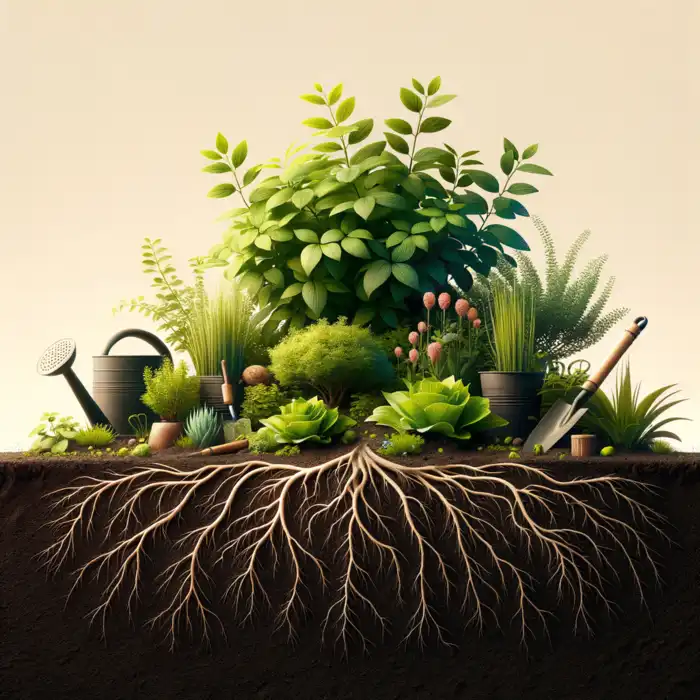
- Tree Species
- Sep 26
2025-03-24
Did you know that the strength of a plant's root system can determine its resilience against diseases and environmental stresses? Understanding and nurturing these roots is essential for any gardener looking to achieve a thriving garden.
Understanding the techniques and nutrients necessary for robust root development can significantly impact plant health. Below is a visual representation of these strategies and their potential impact on root growth.
Healthy root systems are crucial for the success of any plant. They serve as the foundation, providing stability and support while also playing a vital role in nutrient and water absorption. As a gardener, I’ve learned that the strength and health of a plant heavily depend on its root system, which can often be overlooked in the hustle of planting and maintenance.
According to the Colorado State University Extension, roots absorb and transport water and minerals from the soil to the rest of the tree, and also anchor the portion of the tree above ground.
When we think about plant health, we typically focus on leaves and flowers, but roots deserve our attention too! Strong root development ensures that the plant can thrive, especially in challenging conditions. The roots are not just anchors; they are essential for the overall vitality and longevity of the plant.
The process of root development significantly impacts the overall health of plants. Roots absorb water and nutrients from the soil, fueling growth and sustaining life. If roots are weak or damaged, it can lead to stunted growth and increase susceptibility to pests and diseases.
Moreover, roots also store energy and nutrients, which are crucial during periods of stress or when the plant is not actively growing. By fostering strong root systems, we can enhance not just the health of individual plants but also the resilience of our garden as a whole.
Root systems play a direct role in how efficiently plants can absorb nutrients. The more extensive the root system, the better the plant can access vital minerals and water in the soil. I’ve noticed that plants with well-developed root systems tend to grow faster and produce more vibrant foliage.
Additionally, the type of root system also matters. For instance, fibrous roots spread out close to the soil surface, while taproots dive deeper, accessing moisture and nutrients from lower soil layers. It's fascinating how different plants require different types of roots to thrive, and understanding this can help us choose the right plants for our gardens!
Here's a brief recap of the key points discussed so far:
In this article, we’ve learned that healthy root systems are crucial for the vitality of our plants. The techniques and nutrients discussed play a significant role in promoting robust root development. It's important to remember that the right balance of phosphorus, potassium, and nitrogen are essential for nurturing those roots. Additionally, practical watering techniques and soil amendments can greatly improve root health.
To recap, here are some key strategies for enhancing root growth:
By implementing these strategies, you'll not only support strong roots but also contribute to the overall health of your garden. Tailoring your practices to meet the specific needs of each plant can lead to even greater success!
Every plant has unique requirements that can affect its root growth, and understanding these needs is essential for any gardener. For instance, certain plants thrive in sandy soils, while others prefer clay. By assessing the specific needs of your plants, you can adjust your care practices accordingly.
According to the Montana State University Extension, roots spread out both laterally and vertically as the plant grows to take advantage of areas within the soil that have more water and nutrients.
Consider the following factors when tailoring your approach:
These tailored practices can lead to improved root development, ensuring each plant has the best chance to flourish. Remember, happy roots mean healthier plants!
Now that we've covered the essentials, it’s time to put this knowledge into action! Implementing these strategies can lead to immediate improvements in root health, which translates to robust plant growth. Start with small changes, like adjusting your watering schedule or adding a few soil amendments, and watch how your plants respond!
According to the University of Minnesota's Department of Soil, Water, and Climate, incorporating organic matter into your soil enhances aeration and water retention, fostering healthy root development.
To see quick results in root health, consider the following tips:
These easy-to-implement tips can make a noticeable difference in the health of your plants. The more attention you give to your roots, the better your plants will thrive!
One of the best ways to enhance your gardening skills is by connecting with local gardening communities. These groups often share valuable insights, tips, and experiences that can benefit your gardening journey. Whether you join a club, attend workshops, or participate in online forums, engaging with fellow gardeners can provide you with a wealth of knowledge.
Here are some ways to get involved:
By collaborating with others who share a love for gardening, you’ll enhance your understanding of root health and grow a more vibrant garden. Happy gardening!
Here is a quick recap of the important points discussed in the article:
1. Why are healthy root systems important for plants?
Healthy root systems provide stability, absorb nutrients and water, and store energy, which are essential for plant survival and overall vitality.
2. What nutrients are essential for root development?
Key nutrients for robust root development include phosphorus, potassium, and nitrogen.
3. How can I encourage deeper root growth?
Effective watering techniques, such as deep watering, and incorporating organic matter can encourage deeper root growth.
4. What factors should I consider when tailoring care practices for my plants?
Consider soil type, watering frequency, nutrient requirements, and seasonal adjustments when tailoring care practices for specific plants.
5. How can local gardening communities help me improve my gardening skills?
Engaging with local gardening communities can provide valuable insights, tips, and shared experiences that enhance your gardening journey.
